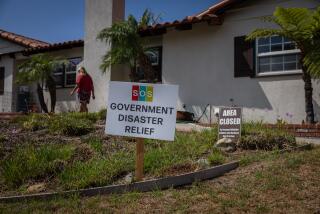Velodrome still coasting into the red but the ride is getting smoother
- Share via
“I don’t expect a crack on this track for the next 100 years,” Ben Schmid said the other day as he stood inside the Olympic Velodrome at California State University, Dominguez Hills.
For the past several weeks, Schmid, a structural engineer, has been overseeing the resurfacing of the velodrome’s 333.33-meter oval track--a $374,000 job undertaken after cracks and bumps appeared in the original track.
Since March 5, about 20 workers, some of whom also helped build the velodrome used for Olympic trials in Colorado Springs, have been laying 4 1/2 inches of reinforced concrete on top of the existing track to ensure that cyclists have a smooth ride.
“About every seven feet, there was a - to 3/4-inch-high bump,” Schmid said, describing the old track. “Now you say that is not very high--unless you are going 45 miles per hour without a spring” on your bicycle seat.
Not all users describe the track’s imperfections--or their effects--in the same way. “It’s kind of like ripples on the cement and they are really wide and big,” said Barbara Roach, a 29-year-old amateur cyclist who lives in Lomita. “You can feel them slightly at high speeds.”
The repaving job--paid for with surplus Olympic funds as well as $30,000 chipped in by the track’s original builder--comes at a time when the university is striving to boost activity at the velodrome.
“In the years since the Olympics, the velodrome has been very much under-utilized,” said Carol Baker Tharp, who was hired last July as the velodrome’s director. “It’s always been a little anomaly sitting over here.”
During the 1985-86 fiscal year, the velodrome, built by the Southland Corp. for the Olympics and donated to the school afterward, wound up with a deficit of about $30,000 after earning about $80,000 in revenue, according to David Karber, the university’s vice president for administration. The losses include maintenance costs and other overhead, as well as promotional expenses for events that did not do well at the gate.
This year, losses are predicted to be about the same, even though revenues are expected to total about $180,000, he said. The Cal State Dominguez Hills Foundation, the nonprofit group that oversees velodrome operations, has loaned money to the cycling center to cover the losses.
Karber said that the school probably did not realize how difficult it would be to operate the $3-million facility profitably.
“I would say no one on the West Coast had any experience in terms of managing a facility like this,” Karber said. “This is a special-purpose facility and you have to adapt it to a general-purpose facility.”
To beef up revenues, Tharp, formerly the director of marketing and programming for the Hult Center for the Performing Arts in Eugene, Ore., has lured events unrelated to cycling to the velodrome in recent months.
For example, commercials for automobiles and a hamburger chain have been filmed at the velodrome, which has also been rented out for concerts, Tharp said.
But Tharp hopes that cycling activity at the outdoor velodrome--one of three in Southern California and the only one on a college campus--will increase in coming months and years. Besides the Golden State Grand Prix races that will be held there starting in May, a new youth cycling development program, offered in cooperation with the Amateur Athletic Foundation of Los Angeles, will begin late next month, she said.
“We believe the market is ripe for cycling to take off,” Tharp said. Unlike other types of bicycle racing, people who attended races in a velodrome do not have to “stand in one spot and wait for a cyclist to come by once every hour,” she said.
Karber said repairs had to be made to the original track even before the 1984 Olympics began because cracks were discovered. A subsequent study conducted by Schmid concluded that there were design errors and carelessness in constructing the facility, and the school eventually convinced the Los Angeles Olympic Organizing Committee that problems would persist unless a new surface was constructed atop the old one, he said.
“We convinced them that the only long-term solution was to do it right,” he said.
Bill Loorz, president of Stolte Corp., which built the velodrome, said he does not believe workers were careless or that design errors were made.
“We used the best technology we could find then. It is really a damn good track, an excellent facility,” Loorz said, adding that some consultants questioned whether resurfacing the track would improve it because concrete typically cracks over time. Schmid said that Mel-Ro Construction, a Colorado Springs-based company chosen to do the Dominguez Hills resurfacing, built the velodrome in that city with success. Although there are some cracks on that track, its surface is very smooth, he said.
The track’s new surface is being built with the same kind of crushed rock used for the Colorado velodrome, Schmid said. A special machine developed by the company is used to lay the concrete on the track’s steep slopes. The work is scheduled to be finished early next month.
“We give this a B plus now,” Schmid said as he talked about the work done thus far. “We’re looking for an A minus.”
More to Read
Go beyond the scoreboard
Get the latest on L.A.'s teams in the daily Sports Report newsletter.
You may occasionally receive promotional content from the Los Angeles Times.






